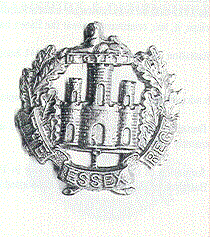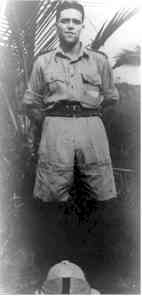

NEVILLE, Stanley Victor
Private 6012753
2/5th Battalion, Essex Regiment
who died
Monday, 25th December 1944. Aged 27
Stanley was the son of George Clifford and Ethel May Neville, of Langenhoe, Essex.
Stanley had 4 brothers all of whom served in the Second World War. The eldest was Robert Coppin, who like Stanley was to die in the Service of his country (see separate page). His brother Cyril served for 4 1/2 years in India with the Queen's Own Royal West Kents. Likewise Bernard was to serve in India with the RAF. The other brother Leonard served at Thetford in Norfolk with the RAF.
Stanley enlisted 4th January 1938 into the Essex Regiment. He went overseas to North Africa on the 17th December 1940. From 17th June 1941 they moved back to what was classified the Middle East.
Stanley served with the 2/5th Battalion of the Essex Regiment, who served in Palestine/Iraq between 15th June 1942 and the 30th June 1942. The 2/5th Battalion were a Territorial Unit drawn predominately from rural areas in East & North Essex. Subsequently, they fought in the Battle of Deir-El-Shein in 1942. Stanley was initially reported missing and then subsequently a prisoner of war of the Germans.

The picture of him above is probably taken in Sierra Leone at Lumley Camp. The 2/5th Battalion camped there, whilst in passage to the Middle East. Whereas other Battalions of the Essex Regiment were living inland, the 2/5th at Lumley were on the coast and vulnerable to mosquitoes. Many of the men suffered afterwards with malaria.
The Battle of Deir-El-Shein on the 1st. July 1942, in which the 2/5th Battalion, The Essex Regiment, fought with particular distinction, marked the turning point of the desert campaign in that year. The actions of the 2/5th were recognized by the award of a Battle Honour to the Essex Regiment.
Prior to the Battle of Alamein, in October 1942, the German forces had forced a general withdrawl to Tobruk and were within 60 miles of Alexandra. General Auchinleck, Commander of the Commonwealth forces, decided to stand and fight at what was to become known as the Alamein Line.
Under the command of Lieutenant Colonel Steve May the 2/5th arrived at Alamein on the 27th June. Short of many supplies such as RE stores, mines and wires and also a shortage of transport, the Battalion converted by indomitable work a piece of bare desert into a reasonably defended locality.
On the 1st July, a hot and very unpleasant day, the Battalion put up a stout fight all day against overwhelming odds. However, the whole Brigade was eventually overrun after stalwart resistance, yet the fighting spirit of the 2/5th Essex was outstanding to the end.
Lieutenant General Sir Willoughby Norrie concluded his account by writing "I am proud to have had troops of the calibre of the 2/5th Battalion, The Essex Regiment under my command. I congratulate Lieutenant Colonel May, his officers and men. They did their duty and did it right well".
The remnants of the Battalion were captured by the Germans and spent the rest of the war in captivity. Lieutenant Colonel May made a daring escape from an Italian POW camp and for his distinguished service was awarded an O.B.E. Stanley similarly made several unsuccessful attempts to escape from captivity.
He died in captivity, as a result of an Allied bombing raid on the factory, where he was being forced to work.
He was entitled to the Defence Medal, the 1939-45 War Medal, the Africa Star with clasp for the 8th Army and the 1939-45 Star




Stanley is commemorated in the Prague War Cemetery, Czech Republic , grave I.E.7.

The Prague War Cemetery is, in fact, a British plot adjoining a boundary wall on the north side of the Civil Cemetery of Olsany. Olsany is on the eastern outskirts of Prague about 3 kilometres from the centre of the city on the main road from Prague to Strasnice. The graves were brought here from 73 small cemeteries scattered all over the Czech Republic. Many of these graves are of POWs.
REFERENCES
Information obtained from The Commonwealth War Graves web site. www.
cwgc.org/ and from the family archives.The description of the Battle of Deir-El-Shein has kindly been provided by the Editor of "The Eagle", the Journal of the Essex Regiment Association.
The Battle of Deir-El-Shein is fully documented on pages 459 to 473 in "The Essex Regiment", 1929 to 1950, by T.A.Martin.
The pictures of the medals were kindly provided by Worcestershire Medal Service Ltd.
08/04/01 last updated
**********************************************************
These pages are dedicated to the memory of the Fallen from the two World Wars, who lived in Abberton & Langenhoe.. Prepared by Saint Andrew's Parochial Church Council. November 11th 2000